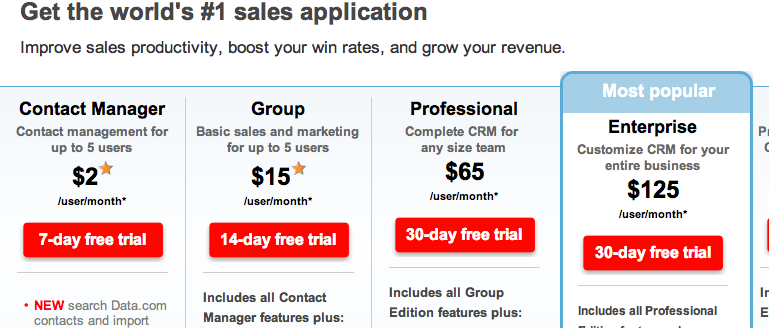SAAS Free Trial: Customer Acquisition Strategies for Sales Success
Free trials are the test drives that get your SaaS products off the lot. They are the best sales pitches in your marketing arsenal, allowing prospects to literally use your services risk-free and without the pressure of an obligatory contract.
At first glance, the process seems simple enough. Why wouldn’t a person want to try something for free? Oh if only it were that simple.
The truth is, there are more than 10,000 established SaaS companies in existence today, many of whom probably share a good portion of your audience. The free trial phase is your first chance to make a lasting impression, and potentially your only chance, so it’s important to go in with a sound plan of attack.
Strategy is everything if you want your SaaS free trial to result in paying customers. In this post, we’ll discuss the contributing factors to consider when constructing your offers and the thought process behind a successful lead nurturing campaign.
SaaS Free Trial Length
The first question on everyone’s mind is “how long should I make my SaaS free trial?” The answer is unfortunate… because there’s no right answer.
When evaluating your free trial offer you have to consider the nature of the specific SaaS product you’re marketing. On average, how long will it take a person to realize your product’s value for them?
A simple perusal of other SaaS companies will expose you to varying free trial lengths. They can span anywhere from 7-days to 30-days, or even up to 60-days. But as customer success expert Lincoln Murphy puts forth, there is a guiding metric designed to help you…
“The length you promote to your prospects has to be long-enough for them to feel like they’re going to be able to adequately evaluate your offering.”
While it’s true that a shorter free trial length promotes a sense of urgency in the consumer, it can also have the reverse effect… preventing them from signing up at all. That’s obviously no bueno.
The length of time needed to truly evaluate a SaaS product will vary from customer to customer. The only way to know if your trial period is long enough is to test it against other lengths.
Here’s how you can go about it…
- Different Lengths for Different Plans
Most SaaS companies offer multiple levels of membership (i.e. free, pro, premium, enterprise, ultra-ultimate platinum, etc.). As you go up, these levels entail a growing set of features. So wouldn’t it make sense that your free trial lengths increase as well?
Take a look at what Salesforce is doing here.
The robust CRM platform recognizes that their customers come in different shapes and sizes. While a large agency will require more time to evaluate their higher ticket SaaS product, a solopreneur might need as little as 7 days to determine if a lower ticket offering is right for them.
Using different trial lengths can give customers more experience with your product, plus it can potentially sway them towards purchasing a higher ticket plan. If for example you’re a fan of Salesforce and are debating between the Contact Manager and Group plans, you might opt for the Group thanks to the 14-day free trial over the 7-day free trial.
Define The Boundaries
Once you decide on the length of your free trial, it’s time to set the parameters. Yes, length is one of these parameters, but you also need to clearly establish the limitations of your offer.
Customers need to know what they’re getting for the next 7- 14- or 30-days, but most importantly they need to know what they’re missing.
This is why it’s so important to offer free trial sign-ups a chance to demo your product.
- Demo Time
So many SaaS companies trip over themselves by NOT offering demos. If you’re experiencing a high abandonment rate from your free trial users, it could be because they’re having trouble understanding your product.
This means either one of two things: your product has ‘under the hood’ issues that require further development, or users simply need better direction while learning it.
I’d recommend looking into the demo option before diving into further development (it’s cheaper). Lowering the abandonment rate could be as simple as throwing up a few tutorial videos.
Funnel creaton software Builderall does a great job of guiding their users through each of the platform’s features. They have an entire YouTube video series taking users by the hand through every imaginable scenario with their software.
They also use a very creative introduction, with a guy on the bottom of the screen who pops out and points to items on the dashboard.
Builderall is fighting an uphill battle, competing against the likes of Clickfunnels and Leadpages in the ultra competitive sales funnel/landing page builder space. Needless to say, subtle enhancements like this help differentiate their brand nicely and let users make the most of the product.
Which leads us to our next section…
Prioritize Education
For sellers, free trials are about setting the fastest road map for leads to go from prospective buyer to paid customer. For buyers, free trials are about learning as much as they can about your product to make an informed purchasing decision.
This is why step-by-step tutorials are so useful. Using videos, infographics, or any other visual means, you need to show people how to get the most of your product by helping them see the high level processes at play.
While creating these tutorials, keep in mind what specific needs your product addresses for each customer. This will help you curate content that is relevant to them, helping users see the true benefits in your product as they apply to them.
- Solving Customer Pain Points
Although it sounds commonsensical, it’s easy to lose track of the true purposes our SaaS product has with regards to our customers’ pain points.
I’d recommend writing out a list of several pain points. It can be exhaustive at first, but the goal is to narrow them down into a top 2-3 that can be addressed in your free trial.
A simplistic example comes from the music streaming platform that millions use, Spotify. The company realizes that it’s the 21st century—meaning no one wants to buy music anymore. So they offer a three month ‘basically’ free trial for 99 cents. This helps wean customers away from the idea of free music over a three month period.
Speaking from personal experience, this strategy works quite well. I had forgotten when my three months were up, but I was so used to the service that I was fine paying the $9.99.
That’s not to say that you should drag your free trial out and sneakily drop in a payment at the end. It just means that Spotify did a great job at solving my pain point as a consumer.
- Email Marketing
Love them, hate them, need more of them? Email marketing often checks all of these boxes. Yes the process of building and communicating with a list can be daunting, but it is still one of the most important marketing processes your SaaS company can undergo. There are tons of rewards and benefits to be had from successful email campaigns.
Once you’ve established your customers’ most imminent pain points (discussed above), your email campaigns become a whole lot easier.
Take them through a series of emails known as the nurture sequence. Here you provide tons of value to address their pain points while endearing them to your brand. This sequence should last the entire length of your free trial offer, and you should send emails to everyone on your list once a day.
Many marketers fear they’ll harass their users by emailing everyday, but during the nurture sequence frequency is key. You need to keep users focused on their free trial and walk them through all the features of your SaaS product.
One of the most information-rich books on the subject of email marketing and sales funnels is Dotcom Secrets by Russell Brunson. In it, he discusses the need for a “soap opera sequence” to nurture leads.
The idea behind a “soap opera sequence” is to take your readers through a calculated journey, from identifying their problem to discovering your product as the solution. The content might differ in the context of your free trial, but the idea remains the same. You want to position yourself as an “attractive character”—in Brunson’s words—so users will like and respect you.
Give Away Just Enough
Give your leads enough value so they understand why your SaaS product rocks, but don’t give away too much key information. Keep them wanting more so they become buyers.
Understand that there are different buyer personas interested in your free trial. Some people will be well acquainted with your product and require less handholding during the nurture phase. Others will need step-by-step tutorials and a longer trial period to get to know your brand.
You can qualify these buyers based on the content they consumed to find your trial offer, then send them through differing email funnels accordingly.
Throughout the SaaS free trial process remember two letters: A and B… combine them, and you’ve got an A/B Test. Keep testing every component of your funnels, gathering the most important bits of data along the way.
Winning the SaaS free trial game isn’t rocket science, it’s just a lot testing and optimization. Then again, isn’t anything?





